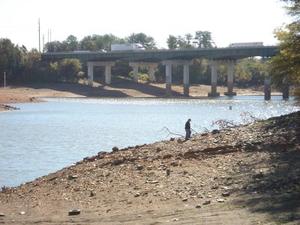The water we drinkDrought-prone pasts may foretell New York's and Atlanta's futures
By fall 2007, during the second year of a three-year drought, Atlanta had roughly three months’ supply of water remaining while Athens, Georgia was down to approximately fifty days; another drought dramatically lowered New York City reservoirs to 33 percent of capacity in 1981; droughts in those cities and their surrounding regions were typically longer and more frequent centuries ago than they were for most of the twentieth century; a return to historic climate patterns would bring more frequent and prolonged droughts

The waters continue to recede // Source: google.com
New York City and Atlanta have both experienced droughts in the past few decades that required them to implement water restrictions and conservation measures. A new study of tree-ring data spanning the past 400 years indicates, however, that droughts in those cities and their surrounding regions were typically longer and more frequent centuries ago than they were for most of the twentieth century. In addition, recent decades have brought longer drought cycles similar to those prevalent before the mid-1800s. A return to drought patterns of past centuries, the study’s authors say, could seriously strain the water resources of both of those densely populated regions.
“We can handle two to three-year droughts, but if three and four and five-year droughts are possible, we’re not prepared,” says Neil Pederson, a research professor with the Tree Ring Laboratory at Columbia University’s Lamont-Doherty Earth Observatory in Palisades, New York, which created the new tree-ring drought records. He adds that the familiar scene in the western United States of fights and lawsuits over water “is starting to play out here in the East.”
By fall 2007, during the second year of a three-year drought, Atlanta had roughly three month’s supply of water remaining while Athens, Georgia was down to approximately fifty days. Another drought dramatically lowered New York City reservoirs to 33 percent of capacity in 1981. A return to historic climate patterns would bring more frequent and prolonged droughts, Pederson says.
He and his graduate students collected tree cores from several species of trees in the Atlanta and New York regions that have lived as long 500 years. The team included additional species that are not usually sampled for drought records, including tulip poplar and hickory, to help better account for annual variability and give a more accurate picture of the wet and dry periods in these regions. It usually takes at least eighteen different tree cores to get a statistically accurate drought record in each forest, Pederson says, and being able to draw on additional tree species helps them find more very old trees that can provide additional data.
The cores show that there were three severe droughts in the 1,700s in the southern Appalachian region that were soon followed by regional die-offs of trees with about 8 to 10 percent of the trees being lost.
Today, “these relatively minor droughts are setting off water conservation measures and draining reservoirs. That’s the scary thing,” given that longer droughts that may lie ahead, he says.
Pederson presented the findings yesterday (22 March) at a conference on Climates, Past Landscapes, and Civilizations. The conference, organized by the American Geophysical Union, has brought together nearly 100 scientists to discuss the latest research findings in archeology, paleoclimatology, paleoecology, and other fields that reveal how changes in regional and global climate have impacted the development and fates of societies.
